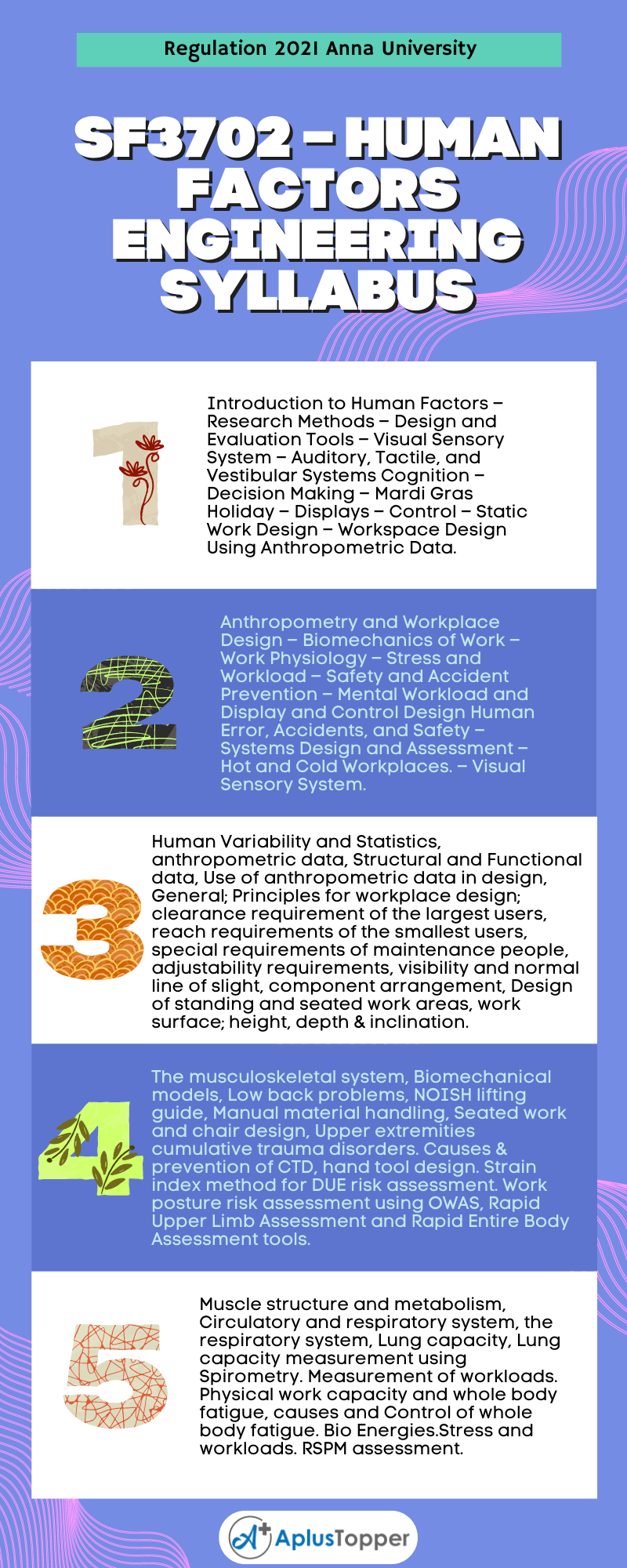In this article, we tried our best to provide the syllabus regarding Anna University awarding the B.E Safety and Fire Engineering syllabus Semester VII subject Human Factors Engineering.
We include more details along with the syllabus of SF3702 – Human Factors Engineering, by the expertise ones with required textbooks and references for additional purposes to make your preparation easy. You just simply follow the unit-wise syllabus to excel in academics. Hope this information is useful. Comment below if you have any doubts relevant to the subject in the given below comment box. Kindly share it with your friends.
If you want to know more about the B.E Safety And Fire Engineering syllabus connected to an affiliated institution’s four-year undergraduate degree program. We provide you with a detailed Year-wise, semester-wise, and Subject-wise syllabus in the following link B.E Safety And Fire Engineering Syllabus Regulation 2021 Anna University.
Aim Of Objectives:
- Describe the meaning and importance of human factors engineering.
- Relate human sensory, cognitive, and physical capabilities and limitations to the design of human-machine systems.
- Select and correctly use appropriate human-machine system analysis and design tools.
- Apply sound human-machine system design principles to develop written and graphical design specifications.
- Recognize and construct proper recommendations to correct human factors deficiencies in human-machine systems in written and/or graphical form.
SF3702 – Human Factors Engineering Syllabus
Unit – I: Human Factors Basics
Introduction to Human Factors – Research Methods – Design and Evaluation Tools – Visual Sensory System – Auditory, Tactile, and Vestibular Systems Cognition – Decision Making – Mardi Gras Holiday – Displays – Control – Static Work Design – Workspace Design Using Anthropometric Data.
Unit – II: Human Performance In The Workplace
Anthropometry and Workplace Design – Biomechanics of Work – Work Physiology – Stress and Workload – Safety and Accident Prevention – Mental Workload and Display and Control Design Human Error, Accidents, and Safety – Systems Design and Assessment – Hot and Cold Workplaces. – Visual Sensory System.
Unit – III: Engineering Anthropometry and Work Place Design
Human Variability and Statistics, anthropometric data, Structural and Functional data, Use of anthropometric data in design, General; Principles for workplace design; clearance requirement of the largest users, reach requirements of the smallest users, special requirements of maintenance people, adjustability requirements, visibility and normal line of slight, component arrangement, Design of standing and seated work areas, work surface; height, depth & inclination.

Unit – IV: Biomechanics Of Work
The musculoskeletal system, Biomechanical models, Low back problems, NOISH lifting guide, Manual material handling, Seated work and chair design, Upper extremities cumulative trauma disorders. Causes & prevention of CTD, hand tool design. Strain index method for DUE risk assessment. Work posture risk assessment using OWAS, Rapid Upper Limb Assessment and Rapid Entire Body Assessment tools.
Unit – V: Work Physiology
Muscle structure and metabolism, Circulatory and respiratory system, the respiratory system, Lung capacity, Lung capacity measurement using Spirometry. Measurement of workloads. Physical work capacity and whole body fatigue, causes and Control of whole body fatigue. Bio Energies.Stress and workloads. RSPM assessment.
Text Books:
- Wickens, C.D., Lee, J.D., Liu, Y., Gordon Becker, S.E. (2004). An Introduction to Human Factors in Engineering (2nd Ed.). Upper Saddle River, New Jersey: Pearson Prentice-Hall.
- Sanders, M.S. and McCormick E.J. (1997). Human Factors in Engineering and Design (7th Ed.). McGraw-Hill, Inc.
References:
- Phillips, C. A. (1999). Human Factors Engineering, 1st edition, Wiley (ISBN- 978- 0471240891).
- Bridger, Robert S. (2009). Introduction to Ergonomics, 3rd edition, CRC Press, Taylor & Francis Group (ISBN – 978-0849373060).
- Introduction to Ergonomics / R. S. Bridger / 3rd edition. Publisher: CRC Press, Taylor & Francis Group ISBN – 978-0-8493-7306-0.
- Sanders Mark S and McCormick Ernert J, “Human Factors in Engineering and Design”, McGraw Hill Inc., 1993.
- John B West, “Respiratory Physiology” WolterKulwer Lippincott Williams & Wilkins.
Related Posts On Semester – VII:
Must Read:
